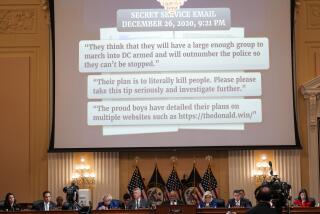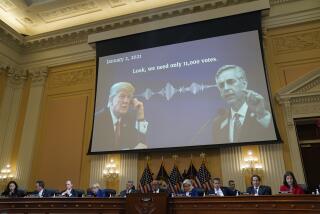U.S. Scare Campaign Against Kadafi Reported
- Share via
WASHINGTON — In August, the Reagan Administration launched a secret and unusual campaign of deception designed to convince Libyan leader Moammar Kadafi that he was about to be attacked again by U.S. bombers and perhaps be ousted in a coup, according to informed sources and documents.
The secret plan, adopted at a White House meeting Aug. 14, was outlined in a three-page memo that John M. Poindexter, the President’s national security affairs adviser, sent to President Reagan.
“One of the key elements” of the new strategy, the Poindexter memo said, “is that it combines real and illusionary events--through a disinformation program--with the basic goal of making Kadafi think that there is a high degree of internal opposition to him within Libya, that his key trusted aides are disloyal, that the U.S. is about to move against him militarily.”
Elaborate Plan
It was an elaborate plan, “a series of closely coordinated events involving covert, diplomatic, military and public actions,” according to Poindexter’s memo.
The plan was the latest phase of the Administration’s policy, first adopted last year, to try to topple Kadafi, a known instigator of terrorist acts.
Beginning with an Aug. 25 article in the Wall Street Journal, American news media reported as fact much of the false information generated by the new plan. Published articles described renewed Libyan backing for terrorism and a looming, new U.S.-Libya confrontation.
But U.S. intelligence officials had actually concluded in August that Kadafi was “quiescent” on the terrorist front, according to the Poindexter memo. The only “confrontation” was the one generated by the Administration plan, according to sources, who declined to be named, and Administration planning papers.
During September, however, U.S. intelligence agencies assembled evidence that Libya had begun planning a number of terrorist attacks, and some senior officials were concerned that this was in part a response to the Administration’s latest campaign against Kadafi.
Of greatest concern to U.S. officials are reports considered reliable but still inconclusive that Libya had a direct hand in the Sept. 5 attempted hijacking of Pan American World Airways Flight 73 at the Karachi airport in Pakistan and provided logistical support for the hijackers, according to informed sources.
When the Administration’s secret deception plan was launched in August, officials acknowledged in internal memos that it might provoke Kadafi into new terrorist acts. But senior officials decided that the potential benefits of the operation outweighed this risk.
The objective of the plan was to keep Kadafi preoccupied and “off balance” and to portray him as paranoid and ineffective so that, as the memo put it, “forces within Libya which desire his overthrow will be emboldened to take action.”
Poindexter’s memo was drafted in preparation for a National Security Planning Group meeting convened to consider the next steps the Administration would take against the Libyan leader.
The President, Poindexter and other key officials met at the White House on Aug. 14 and approved the basic plan, sources said. Details were left to Poindexter, the State Department and the CIA.
New Intelligence
Soon after the meeting, Administration officials told reporters that the United States had new intelligence indicating that Kadafi was again stepping up his terrorist plans, following a four-month lull after the April 14 American bombing raid against Libya.
But Poindexter’s memo to Reagan just before the Aug. 14 meeting painted a less alarming picture: “Although the current intelligence-community assessment is that Kadafi is temporarily quiescent in his support of terrorism, he may soon move to a more active role.”
More to Read
Sign up for Essential California
The most important California stories and recommendations in your inbox every morning.
You may occasionally receive promotional content from the Los Angeles Times.












